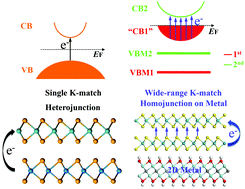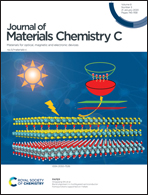Band alignment in multilayered semiconductor homojunctions supported on metals†
Abstract
To solve the intractable problem of momentum-mismatch in heterojunctions, we propose a universal approach to obtain type II band alignment in two-dimensional (2D) semiconductor homojunctions with wide range momentum-space-match by a band-nesting effect. 2D homojunctions are implemented in van der Waals multilayered semiconductors through supporting them on a metal surface. There are two advantages in 2D multilayered semiconductor homojunctions (MSHs) compared to 2D heterojunctions: (1) momentum-matched band alignments are easy to achieve due to the inherent lattice-orientation-match between van der Waals layers of the same 2D material, and moreover, a wide-range momentum-space-match can be obtained by metal-induced Fermi-level movement to achieve ‘parallel’ band edges in degenerately doped MSHs; and (2) largely tunable band offsets make band alignment change from type II to type III to inversed type II due to the charge redistribution at the junction interfaces. In addition, we found that 2D MSHs are better supported on 2D metals (e.g. MXene) rather than 3D metals (e.g. Pt), with the advantages of being free of metal-induced-gap-states and easily obtained n- and p-type Schottky-barrier-free contacts. Thus, our proposed van der Waals homojunctions, with unexpected excellent properties compared to heterojunctions, stimulate studies on their various applications.



 Please wait while we load your content...
Please wait while we load your content...